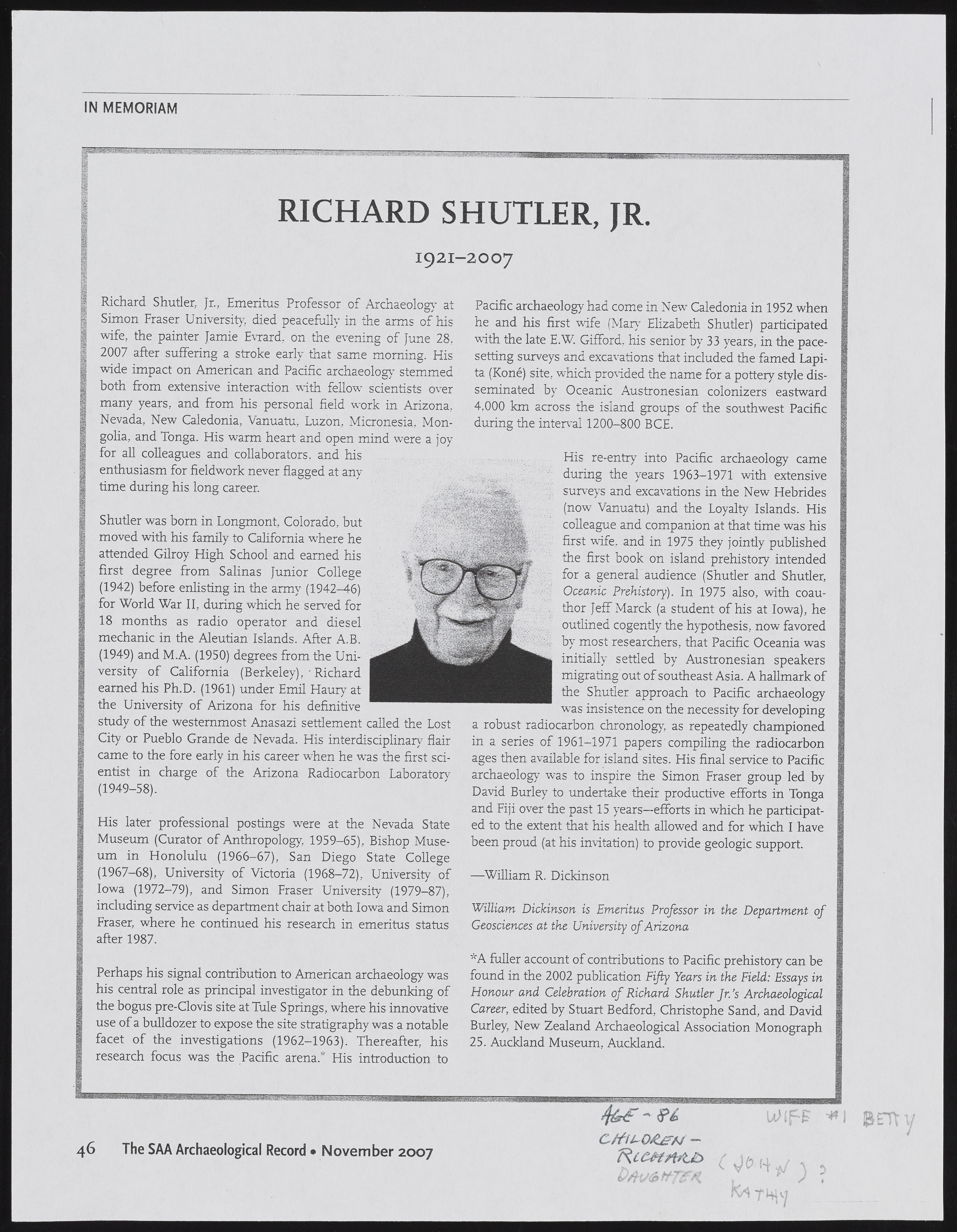Copyright & Fair-use Agreement
UNLV Special Collections provides copies of materials to facilitate private study, scholarship, or research. Material not in the public domain may be used according to fair use of copyrighted materials as defined by copyright law. Please cite us.
Please note that UNLV may not own the copyright to these materials and cannot provide permission to publish or distribute materials when UNLV is not the copyright holder. The user is solely responsible for determining the copyright status of materials and obtaining permission to use material from the copyright holder and for determining whether any permissions relating to any other rights are necessary for the intended use, and for obtaining all required permissions beyond that allowed by fair use.
Read more about our reproduction and use policy.
I agree.Information
Digital ID
Permalink
Details
More Info
Rights
Digital Provenance
Publisher
Transcription
IN MEMORIAM l sim B RICHARD SHUTLER, JR. 1921-2007 Richard Shutler, Jr., Emeritus Professor of Archaeology7 at Simon Fraser University; died peacefully in the arms of his wife, the painter Jamie Evrard, on the evening of June 28, 2007 after suffering a stroke early that same morning. His wide impact on American and Pacific archaeology7 stemmed both from extensive interaction with fellow scientists over many years, and from his personal field work in Arizona, Nevada, New Caledonia, Vanuatu, Luzon, Micronesia, Mongolia, and Tonga. His warm heart and open mind were a joy for all colleagues and collaborators, and his enthusiasm for fieldwork never flagged at anv time during his long career. Shutler was bom in Longmont, Colorado, but moved with his family to California where he attended Gilroy High School and earned his first degree from Salinas Junior College (1942) before enlisting in the army (1942-46) for World War II, during which he served for 18 months as radio operator and diesel mechanic in the Aleutian Islands. After A.B. (1949) and M.A. (1950) degrees from the University of California (Berkeley), * Richard earned his Ph.D. (1961) under Emil Haury at the University of Arizona for his definitive study of the westernmost Anasazi settlement called the Lost City or Pueblo Grande de Nevada. His interdisciplinary flair came to the fore early in his career when he was the first scientist in charge of the Arizona Radiocarbon Laboratory7 (1949-58). His later professional postings were at the Nevada State Museum (Curator of Anthropology, 1959-65), Bishop Museum in Honolulu (1966-67), San Diego State College (1967-68), University of Victoria (1968-72), University of Iowa (1972-79), and Simon Fraser University (1979-87), including service as department chair at both Iowa and Simon Fraser, where he continued his research in emeritus status after 1987. Perhaps his signal contribution to American archaeology was his central role as principal investigator in the debunldng of the bogus pre-Clovis site at Tule Springs, where his innovative use of a bulldozer to expose the site stratigraphy was a notable facet of the investigations (1962-1963). Thereafter, his research focus was the Pacific arena." His introduction to ilSlSSSb. m g tm t Pacific archaeology had come in New Caledonia in 1952 when he and his first wife (Mary7 Elizabeth Shutler) participated with the late E.W. Gifford, his senior by 33 y7ears, in the pacesetting surveys and excavations that included the famed Lapi-ta (Kone) site, which provided the name for a pottery style disseminated by Oceanic Austronesian colonizers eastward 4,000 km across the island groups of the southwest Pacific during the internal 1200-800 BCE. His re-entry7 into Pacific archaeology came during the yrears 1963-1971 with extensive surveys and excavations in the New Hebrides (now Vanuatu) and the Loyalty Islands. His colleague and companion at that time was his first wife, and in 1975 they jointly published the first book on island prehistory intended for a general audience (Shutler and Shutler, Oceanic Prehistory). In 1975 also, with coauthor Jeff Marck (a student of his at Iowa), he outlined cogently the hypothesis, now favored by most researchers, that Pacific Oceania was initially settled by Austronesian speakers migrating out of southeast Asia. A hallmark of the Shutler approach to Pacific archaeology wras insistence on the necessity for developing a robust radiocarbon chronology, as repeatedly championed in a series of 1961-1971 papers compiling the radiocarbon ages then available for island sites. His final service to Pacific archaeology was to inspire the Simon Fraser group led by David Burley to undertake their productive efforts in Tonga and Fiji over the past 15 years—efforts in which he participated to the extent that his health allowed and for which I have been proud (at his invitation) to provide geologic support. —William R. Dickinson William Dickinson is Ementus Professor in the Department of Geosciences at the University of Arizona *A fuller account of contributions to Pacific prehistory can be found in the 2002 publication Fifty Years in the Field: Essays in Honour and Celebration of Richard Shutler J r 's Archaeological Career, edited by Stuart Bedford, Christophe Sand, and David Burley, New Zealand Archaeological Association Monograph 25. Auckland Museum, Auckland. 4 6 The SAA Archaeological Record • N o v e m b e r 2 0 0 7 H c e & r tttib f \ 4, & 1*77+ A I I ? #Mf Mid* THty

